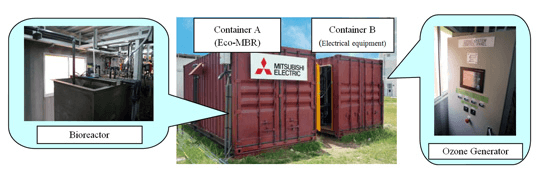Jul 11 2016
Mitsubishi Electric Corporation plan on conducting a field test of its Ozone Backwashing Energy-Saving Membrane Bioreactor (Eco-MBR), which is designed to handle recycling of industrial wastewater and sewage with less energy consumption at the Public Utilities Board's (PUB), Singapore's national water agency, Changi Water Reclamation Plant (CWRP).
 Eco-MBR field test site at Changi Water Reclamation Plant, Singapore (Mitsubishi Electric)
Eco-MBR field test site at Changi Water Reclamation Plant, Singapore (Mitsubishi Electric)
In comparison to the traditional MBRs, the field test aims to validate that the Eco-MBR, can potentially decrease energy consumption and significantly increase the amount of permeated water per membrane filter surface area (flux), which has been made possible with a filter-cleaning technique using ozonated water.
Currently, Mitsubishi Electric is working on practical applications for sewage, industrial water treatment and recycling systems, which would hopefully contribute to universal efforts to accomplish sustainable water environments.
Mitsubishi Electric with its technological expertise of over 1700 delivered ozone generators, has been building its high-performance Eco-MBR as a solution for areas across the globe where there is an increased demand for water.
Due to inadequate water resources in Singapore, the industry and government are successfully using water-reuse solutions to offer substitute, sustainable supplies of water, particularly for industrial use.
At present, Singapore's supply of drinkable recycled water referred to as NEWater is enough to meet 30% of the country’s water needs. Until December 2016, this pilot-scale research will be conducted in partnership with the PUB and the Centre for Water Research at the National University Singapore. The Eco-MBR will be commercialized by the year 2018.
To this point, the tests reveal that the Eco-MBR is capable of realizing a high-quantity flux, or amount of permeated water per membrane surface area, which is more than twice the rate of traditional MBRs.
It is essential to backwash the membranes with highly concentrated ozonated water on a regular basis so as to get rid of almost all organic foulants, thus optimizing membrane permeability. Additionally, the Eco-MBR decreases energy consumption by applying a minimized flow rate for air bubbles that are released from a blower to clean the membrane surfaces.
Fewer membranes are only required by the Eco-MBR, which results in smaller system and plant footprints.
In the near future, Mitsubishi Electric will be involved in working toward commercial application of its Eco-MBR in industrial and municipal water-reuse systems, with a specific goal of contributing to water sustainability across the world.